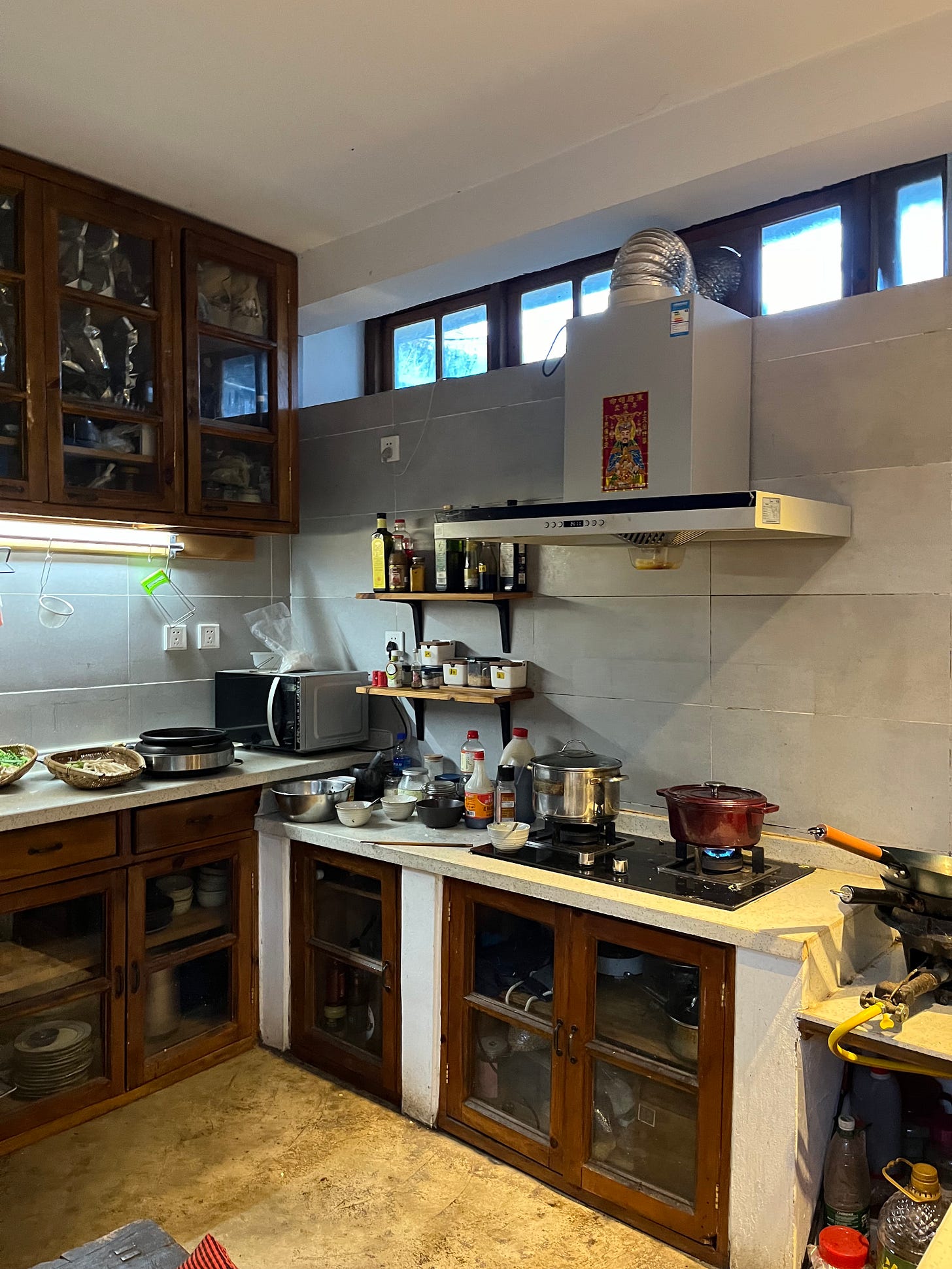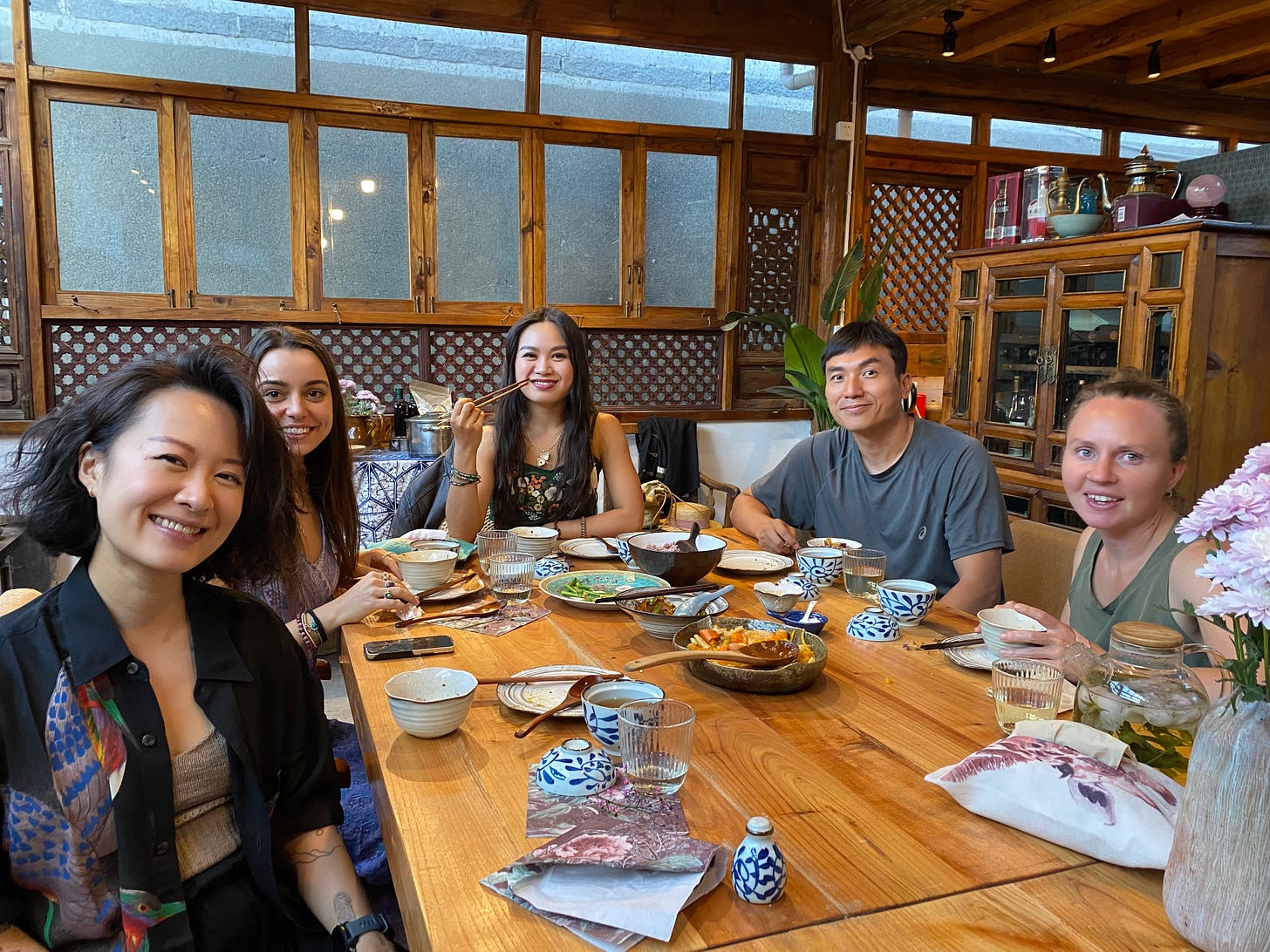Chef Amo and her private kitchen restaurant (私厨)
A foraged vegan dinner in a 130-year old house
Back in April my friend invited me to dinner at what I thought was a vegan Indian restaurant. The address led to a white-walled village courtyard. I followed photo instructions through the garden and up a dusty staircase to an apartment, where an elderly Chinese lady greeted me with a radiant smile and a pair of slippers. She was Jayasri, the chef and sole proprietor. The dining area was furnished with no tables or chairs, just a bookshelf of Sanskrit literature and rose petals scattered in the shape of an ancient Hindu swastika. We sat cross-legged on cushions and sipped hot water from tin cups as we waited.
The food was good, simple home-cooking: a bracing mint chutney, spicy aloo gobi, warm wads of wholegrain roti and sweet rich balls of besan ladhu for dessert. Chef Jayasri operated her kitchen from Monday to Friday alongside her yoga practice, and priced her vegan allium-free meals at 20 RMB, less than three US dollars per person.
“Only in Dali,” my friend whispered, as we cleaned our plates and stretched back to a standing position.
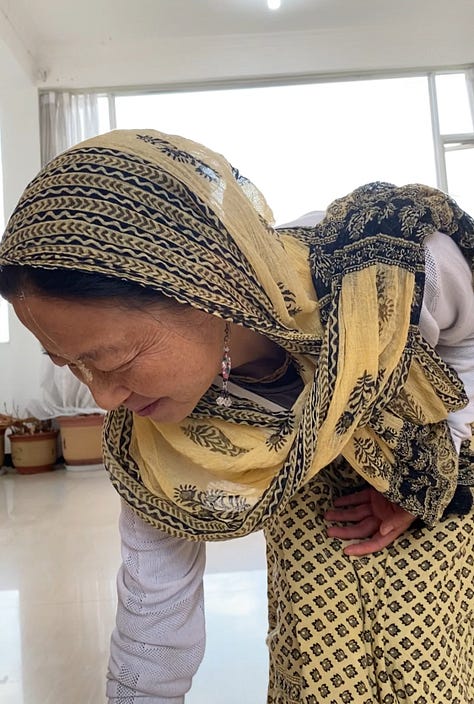


Dali used to be a hub for those seeking an alternative lifestyle in China. Before the recent domestic tourism boom, it was a sleepy mountainous town on the eastern edge of the Tibetan plateau, inhabited by the Bai ethnic minority and attracting hippies, remote workers, backpackers, and artists since the 1980s. “Dali is remote and pretty tolerant and very fluid, and it has all kinds of people. And most of those people are weird,” Mr. Zhou said in a recent NY Times article. The city’s nickname? “Dalifornia.”
I’ll admit, I was drawn to Dali for predictable reasons. Mostly the slow pace of living, the low rent, the vegan Chinese community, and relative political tolerance, or at least the illusion of it. I loved Shanghai but after three months I wanted quiet and I missed mountains, and I felt I could breathe again in Yunnan’s remoteness, in its dense forests and open-air markets where the produce was so flavorful it ruined my standards forever.
Last Tuesday I got to eat a dinner prepared by Amo 阿莫. She’s a chef who moved to Dali twelve years ago to research the traditions of the Bai and Yi ethnic minorities, the indigenous people of the province.
In 2015, the government began demolishing old Dali houses, replacing them with houses with reinforced concrete. Amo bought a compromised 130-year old courtyard house with a collapsing roof and turned it into her home and private kitchen. She took trips out to the countryside to collect discarded wooden doors and windows and other salvageable construction, and hired Bai stonemasons and carpenters to rebuild the house according to traditional construction practices and rituals. They installed wooden flooring in the bedrooms and revamped the old, dark kitchen, preserving the original cabinetry. Amo found Qing-dynasty wedding cabinets and repurposed them as bedside tables. (She now rents out the bedrooms for short-term homestays.)
Private kitchens or 私厨 are restaurants run inside homes, booked by reservation only. Chef Amo prefers a group of 4-8 people, and charges 99 RMB (about $14 per person) for ten dishes.
Her food has a very Yunnan aesthetic— unfussy, simple dishes with local cooking methods, often incorporating acidic, astringent, and other challenging flavors. “I foraged the palm flowers in the salad myself, and had to soak them for several days,” she said. “Otherwise they can be very bitter.” She pairs them with peaches, endive, and a creamy dressing, and they taste like nuts, crunchy with fragrance.
The abundance of private kitchens in Dali is a result of two factors: the low cost of rent and ingredients, and the ability to run a food business in a place of residence. Many chefs started out in food service in another city and ended up staying in Dali longterm, realizing they could actually sustain a food business by word-of-mouth.
Part of the appeal of these meals is the chance to eat food you probably wouldn’t get in a restaurant. It’s also the experience of the space, of being invited into someone’s home. To book a reservation, you add the chef’s WeChat contact and send them a message. Sometimes they’ll post their menus a few days in advance.

Chef Amo asks about each guest in the party before she plans the menu. “No cashews, vegan, no raw tomatoes, alliums are okay,” she’d noted. It’s a one-woman show: she doesn’t need staff. She prepares the appetizers and mise-en-place before guests arrive, and stir-fries each dish as she serves them.
When did you start cooking?
I grew up in Shanghai with grandparents from Suzhou and Shandong, who cooked daily. My mother was also obsessed with food and she’d take me to restaurants in the city starting from the time I was four years old, both Western cuisine and local spots. I think because I was surrounded by good food growing up I naturally developed a good palate and eye for creating my own dishes.
What do you think about when you’re creating dishes?
I consider the harmony of flavors and tastes, and the intention behind each element. Nothing should be gratuitous.
I think about temperature a lot when cooking. Temperature includes both cooking temperature and emotional temperature (情感的温度). For the latter, it means I put myself in the position of a family member or friend. For example, if there are elderly guests with bad teeth, I’ll make the food softer; if there are children, I’ll plan something crispy and fragrant. If I serve four dishes and turn around to find that the guests have finished eating, there’s no need to ask how they like it. If the guests barely touch one of them, I’ll know to adjust the flavors for the following dishes.
Almost all of my dishes are informed by local cooking methods. Over the years, I’ve moved away from complicated manipulation of wild ingredients to simplicity. The most important question is, how do I best showcase the flavor of this wild vegetable? Ingredients from the mountains must retain their wildness.
When you’re cooking wild greens, for instance, if the taste is no different from ordinary greens, if you’re trying to completely remove its bitterness and astringency, then it loses its character. Vegetables are like people, they have their own temperament and you have to respect that. Previously I wanted to neutralize strong tastes, but my perspective has changed. If something is numbing and sour, I’ll pair it with something that complements those flavors.

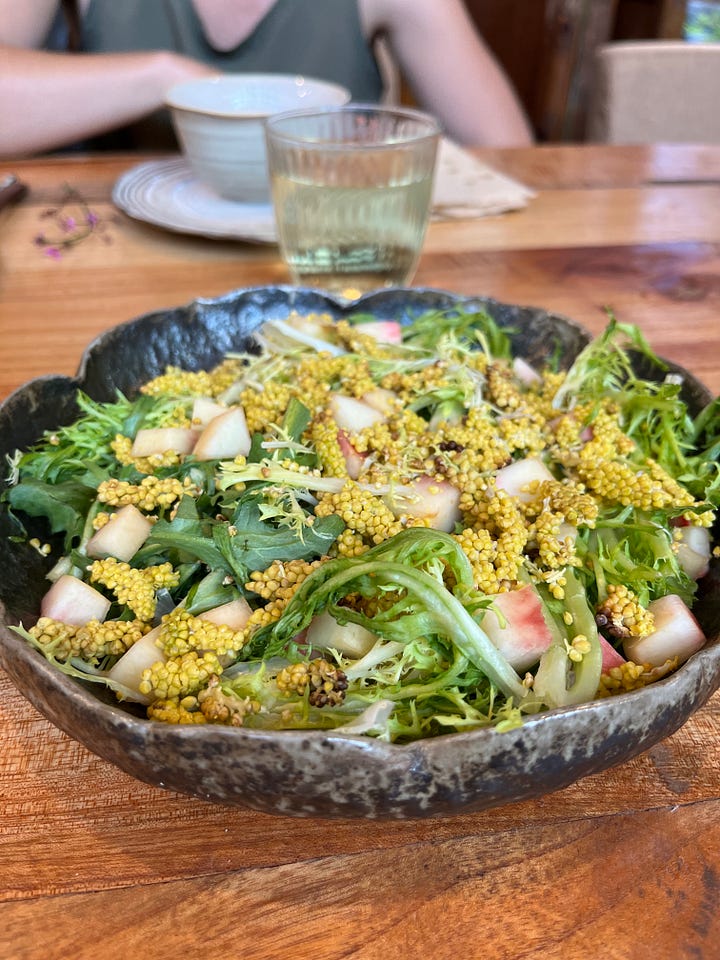
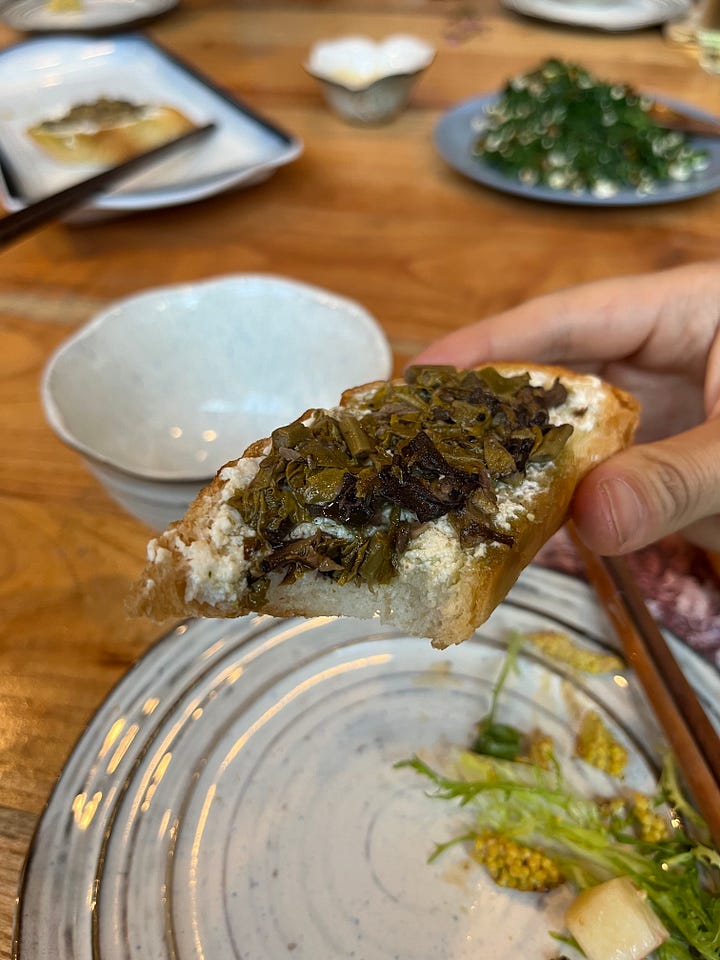
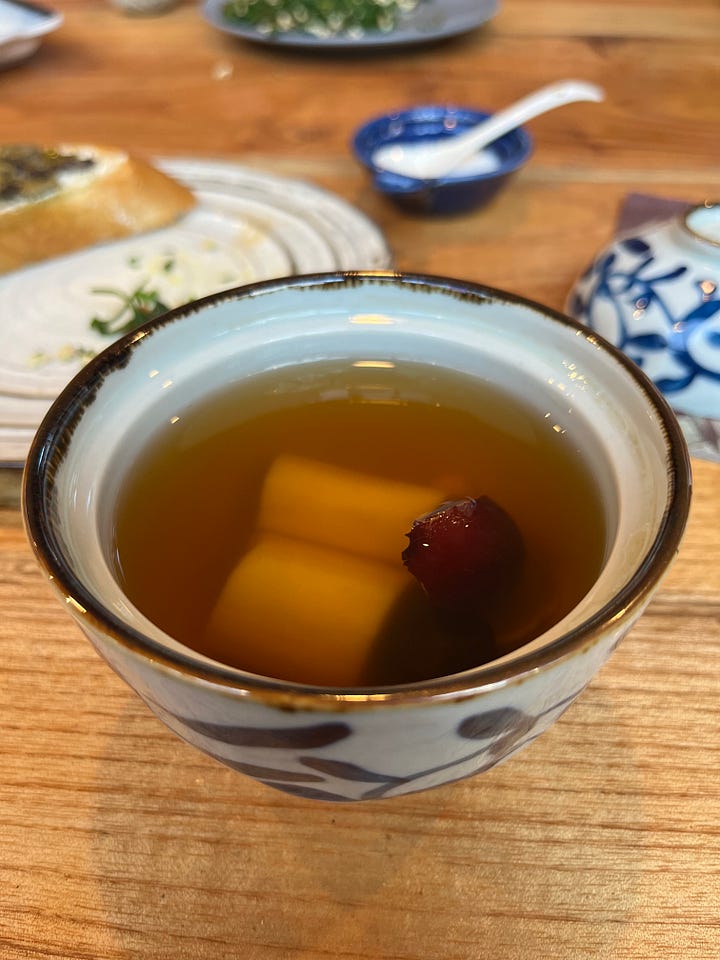
The menu
To begin: a round of herbal tea, steeped with pandan leaves and fresh rose petals.
Starters 前菜:
Blanched wild greens, with smoked pressed tofu and a topping of fried mujiangzi, a pungent, peppery shrub berry native to Yunnan (Litsea pungens hemsl). 野菜拌豆干木姜子
Palm tree flowers and endive salad with peaches, and a creamy walnut-based dressing. 棕苞花苦菊水果色拉
Toasts with a creamy tofu spread and savory toon jam (leaves and tender shoots from the Chinese mahogany tree). 香椿酱
The soup: a slow-simmered broth of Solomon seal rhizome, steamed and sun-dried nine times, with Chinese mountain yam and kidney beans. 九蒸九晒黄精山药红豆老火汤

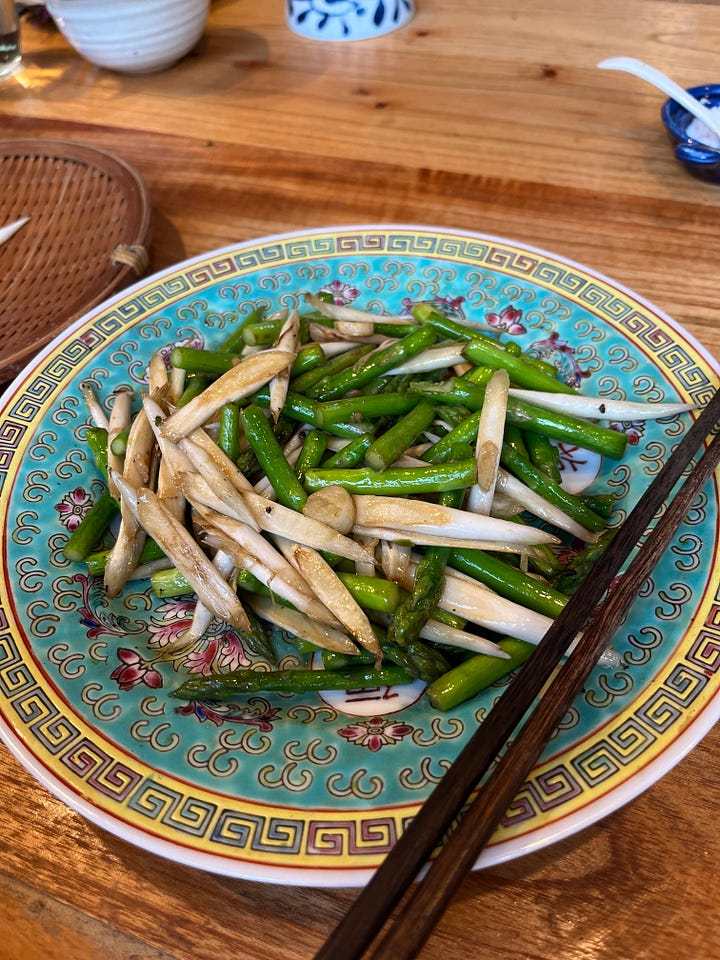
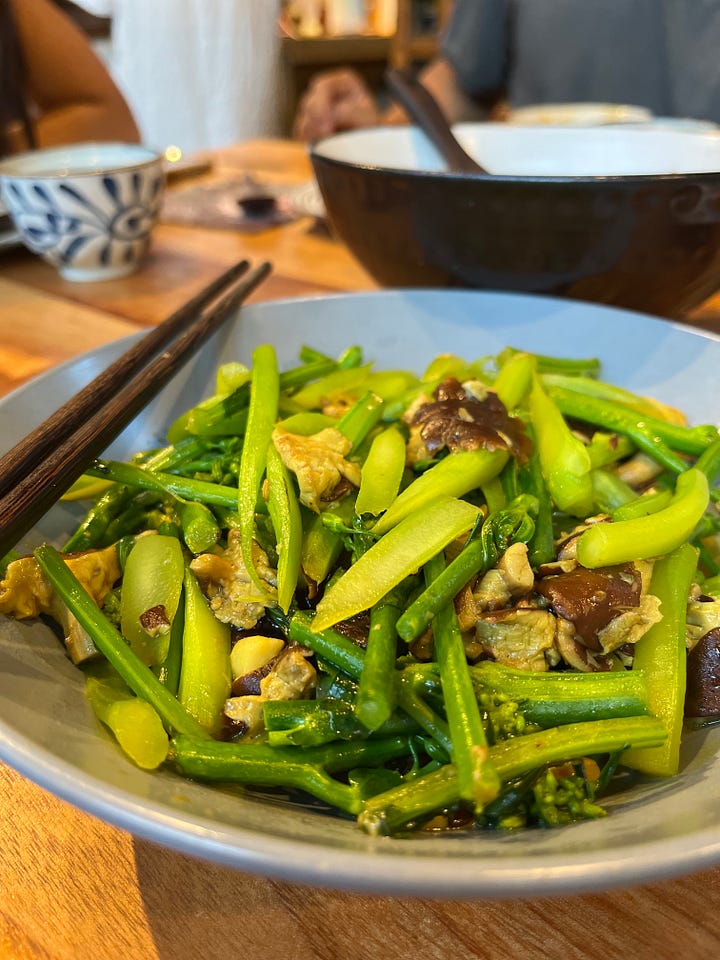
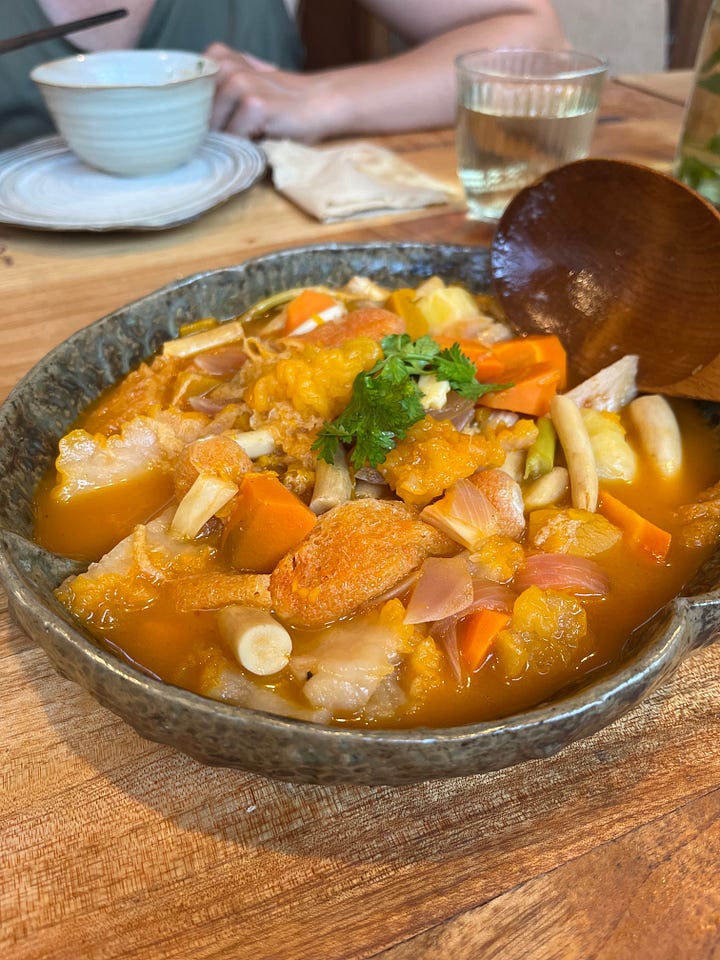
Hot dishes 热菜:







